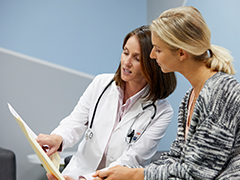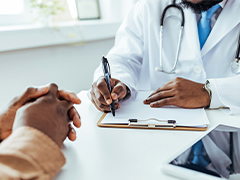Mammograms: Your Questions Answered

What are mammograms?
A mammogram is a low-dose X-ray of the breast. It’s one of the most effective ways of detecting breast cancer.
Why do I need them?
Mammograms save lives. They allow you to detect breast cancer early and begin treatment as soon as possible. And when you start treatment earlier, it’s often more effective and you typically have more options available.
Do I still need mammograms if I perform self-examinations?
Yes. Self-screenings are important, but breast cancer can’t always be felt. Mammograms help detect it up to three years before lumps are even felt or cause symptoms.
Are they safe?
Yes. While X-rays do use radiation to produce a picture, it’s about the same amount of radiation you’re exposed to on a flight across the U.S. And experts agree: it’s worth it to detect breast cancer.
What happens during a mammogram?
You stand in front of an X-ray machine. A technologist will place your breast on a plate and put another on top to flatten it. This allows them to get an X-ray from above. This is repeated on the sides to get another view. Then, they’ll do the same on the other breast.
Like when you get X-rays taken at the dentist, the technologist will make sure the images are clear enough to use before moving on. Within a few weeks, a radiologist will examine them for signs of breast cancer and send you and your doctor the results.
What do they feel like?
Flattening the breast tissue provides a clearer view of the breast. Some may find the pressure from the plates painful, while others may find it merely uncomfortable. Keep in mind that the imaging process is very quick and important for early detection.
How often do I need them?
According to the U.S. Preventive Services Task Force, people assigned female at birth with average risk of breast cancer should have mammograms every two years starting at age 40.
Your doctor may recommend a more frequent schedule if you have higher risk factors, like a family history of breast cancer.
What happens if something is spotted on my mammogram?
It doesn’t necessarily mean cancer. Same goes for if you’re referred to a breast specialist or surgeon. More tests are usually needed to determine the cause.
Are mammograms covered?
Yes. All routine preventive care, including cancer screenings like mammograms, are free for FEP members when visiting Preferred providers. Click here to learn more about our preventive care benefits.
Sources:
https://www.fda.gov/consumers/womens-health-topics/mammography
https://www.cancer.org/cancer/latest-news/what-to-know-about-getting-a-mammogram.html
https://www.covenanthealth.com/take-it-from-a-radiologist-dont-delay-your-mammogram/
https://www.uspreventiveservicestaskforce.org/uspstf/


